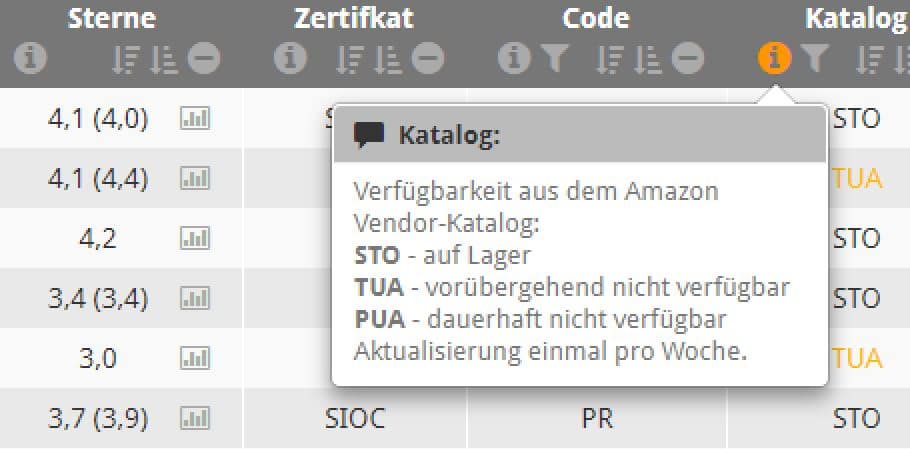
Planned Replenishment, OB, in season, off season, greenlight, … the Amazon Vendor Central contains many different codes and abbreviations for the availability status of your listed products.
In this article, you will learn which codes are in use, which of the restocking and replenishment codes you need to keep an eye on, and where you can find and update the codes in the Amazon Vendor Portal.
What are replenishment codes?
Amazon internally assigns different codes for each item listed, so that the order system can recognize whether the product is orderable and should be ordered. If an article has a wrong code, Amazon no longer orders it from you, it is not available directly from Amazon on the Amazon website, visibility decreases, fewer customers click on it, this leads to less demand -> the downward spiral is in full swing.
What Amazon internal replenishment codes are there and where can you find them?
| Replenishment Code | explanation | Meaning | Where to find |
| PR | Planned Replenishment | Will be reordered automatically, standard code | table of costs, ARA |
| BR | Basic Replenishment | Only reordered manually | table of costs, ARA |
| LR | Limited replenishment | Will be reordered if required | table of costs, ARA |
| OB | Obsolete | No longer available, will not be ordered | table of costs, ARA |
| NR | Non replenishable | Not available | table of costs, ARA |
| OF | Off season | Seasonal articles out of season | table of costs, ARA |
| IS | In season | Seasonal articles during the season | table of costs, ARA |
| NP | New Product | Newly listed product | table of costs, ARA |
| NS | Dropship | not in Amazon warehouse | table of costs, ARA |
| AL | Allocated | Only reordered manually | table of costs, ARA |
| OP | Out of Print | no longer produced, EOL | Case |
| UN | Unknown | Status unknown | table of costs, ARA |
| NY | Not Yet Published | not yet released, new article | Case |
| Greenlight | Availability | ASIN currently available from supplier | Case |
| In stock | In stock | Articles are automatically reordered by Amazon if required | VC Catalog |
| Temporarily unavailable | Temporarily unavailable | Not ordered by Amazon | VC Catalog |
| Permanently unavailable | can not be offered any more | Not ordered by Amazon | VC Catalog |
What are the most important codes and where can you check and change them quickly?
The fastest and most reliable way to check the current product status is to check the Vendor Central catalog. To do this, go to Article -> Catalog -> Update availability in your Vendor Central.
Choose between three options:
- In stock
- Temporarily unavailable
- Permanently unavailable
Changes at this point have an immediate effect on the ordering process.
The “Catalog” feature is available in most vendor categories and replaces the time-consuming availability management per case. If this menu item is not available in your VC, request the availability list per case. Use this text module so that the support employee knows exactly what to do:
“Dear team, please send us an overview for VendorCode XYZ with the following contents:
- ASIN
- item_name.value
- model_number_value
- ean.value
- availability_lifecycle.value
- replenishment_category.value”
Different systems – different codes
[box type=”info”] Articles can have different, even contradictory, restocking codes within Amazon. An article can be marked with “PR” in the cost list, but in the catalogue it is set to “temporarily unavailable”.[/box]
This is how you reliably communicate your current availability to Amazon:
1. update via article -> Catalog -> Update availability
Best, fastest and easiest way. Should generally already have an effect on the next orders. Disadvantage: no bulk upload possible.
2. about the order confirmation codes in the current vendor orders
Simple and without double effort. Availability is updated immediately upon order confirmation. Disadvantage: goes only in one direction (available to not available). Not always reliable in implementation on the part of Amazons.
3. about the confirmed quantities in the purchase orders (including EDI transmissions)
In the case of multiple rejections of POs or partial deliveries, the Amazon order algorithm automatically switches the item to “not available”. Disadvantage: goes only in one direction (available on not available). Not always reliable in implementation on the part of Amazons.
4. per case management
Time consuming. Only recommended if catalog function is not yet available, or does not work.
YellowSky Service
You need support in Vendor Central Management? Contact us and our experts will be happy to help you.




